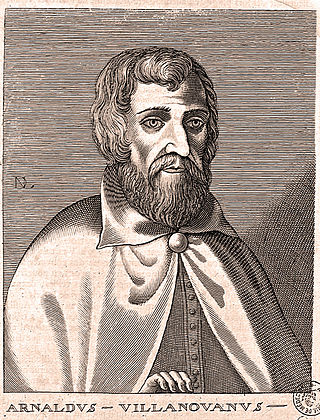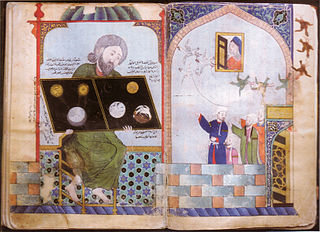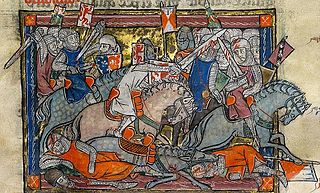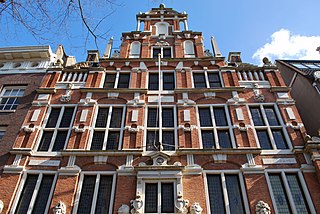
Hermeticism or Hermetism is a philosophical and religious system based on the purported teachings of Hermes Trismegistus. These teachings are contained in the various writings attributed to Hermes, which were produced over a period spanning many centuries and may be very different in content and scope.

The Aurora consurgens is an alchemical treatise of the 15th century famous for the rich illuminations that accompany it in some manuscripts. While in the last century, the text has been more commonly referred to as "Pseudo-Aquinas", there are as well arguments in favour of Thomas Aquinas, to whom it has originally been attributed in some manuscripts. The translated title from Latin into English is "Rising dawn."

Arnaldus de Villa Nova was a physician and a religious reformer. He was also thought to be an alchemist: the door to his house in Montpellier, France, had carved depictions of a roaring lion and dragon biting its own tail, both alchemical symbols, and several renowned alchemists recognized him as an adept. He was also known as an astrologer.
Adam McLean is a Scottish writer on alchemical texts and symbolism. In 1978 he founded the Hermetic Journal which he published until 1992 during which time he also started publishing the Magnum Opus Hermetic Sourceworks, a series of 55 editions of key source texts of the hermetic tradition. From 2004 he began collecting tarot cards in order to document tarot art and built up a collection of 2500 items. In 2016 he set up the Surrealism Website in order to document surrealist painters. This currently shows the work of 100 surrealist artists. He also created a series of 20 video lectures on many facets of surrealist paintings. In 2017 he set up an art gallery The Studio and Gallery in Kilbirnie in North Ayrshire in order to promote the work of emergent and lesser-known artists.

Bibliotheca Philosophica Hermetica (BPH) or The Ritman Library is a Dutch library founded by Joost Ritman located in the Huis met de Hoofden at Keizersgracht 123, in the center of Amsterdam. The Bibliotheca Philosophica Hermetica brings together manuscripts and printed works in the field of Hermeticism, more specifically the 'Christian-Hermetic' tradition.
Petrus Bonus was a late medieval alchemist. He is best known for his Precious Pearl or Precious New Pearl, an influential alchemical text composed sometime between 1330 and 1339. He was said to have been a physician at Ferrara in Italy, causing him to sometimes be known as Petrus Bonus of Ferrara or as Petrus Bonus the Lombard. An Introduction to the Divine Art is also attributed to him but was printed much later, in 1572.
John Dastin (c.1293-c.1386) was an English alchemist of the fourteenth century. Little is known of his life beyond the texts which are attributed to him. Dastin is known for correspondence with Pope John XXII and Cardinal Napoleone Orsini in defense of alchemical practice, dated to 1320.

Muḥammad ibn Umayl al-Tamīmī, known in Latin as Senior Zadith, was an early Muslim alchemist who lived from c. 900 to c. 960 AD.
Hugo of Santalla was a significant translator of the first part of the twelfth century. From Arabic originals, he produced Latin translations of texts on alchemy, astronomy, astrology and geomancy.

Theatrum Chemicum is a compendium of early alchemical writings published in six volumes over the course of six decades. The first three volumes were published in 1602, while the final sixth volume was published in its entirety in 1661. Theatrum Chemicum remains the most comprehensive collective work on the subject of alchemy ever published in the Western world.
The Buch der heiligen Dreifaltigkeit is an early 15th-century alchemical treatise, attributed to Frater Ulmannus, a German Franciscan.
The following outline is provided as an overview of and topical guide to alchemy:

The Rochefoucauld Grail is a four-volume 14th-century illuminated manuscript. Three volumes were formerly Amsterdam, Bibliotheca Philosophica Hermetica, MS 1; the fourth volume is divided between the Bodleian Library in Oxford and the John Rylands Library in Manchester. It contains the Lancelot-Grail cycle in French prose, the oldest and most comprehensive surviving version of the legend of King Arthur and the Holy Grail. The leaves are about 405 mm by 295 mm, and are written in two columns, by a number of scribes.
De Alchemia is an early collection of alchemical writings first published by Johannes Petreius in Nuremberg in 1541. A second edition was published in Frankfurt in 1550 by the printer Cyriacus Jacobus.

Christopher of Paris was an Italian alchemist active at the end of the fifteenth century and author of a number of treatises influenced by pseudo-Lull. He lived in Venice and is supposed to have had contacts among local glassmakers like Angelo Barovier.
Alphidius, also known as Asfidus, Alfidius, Alvidius, is the author name of an unknown, probably medieval Arab alchemist. Nothing is known about him, except some citations and his writings in the 14th century.

The Embassy of the Free Mind is a museum, library and platform for free thinking, inspired by the philosophy of the Bibliotheca Philosophica Hermetica collection. The museum focusses on the European culture of free thinking of the past 2.000 years, with Hermetic wisdom as the source of inspiration: insight into the connection between God, cosmos and man. This connection is reflected in the Hermetic, alchemical, astrological, magical, mystical, kabbalistic and Rosicrucian texts and images in the collection.
Solomon or Salomon Trismosin was a legendary Renaissance alchemist, claimed possessor of the philosopher's stone and teacher of Paracelsus. He is best known as the author of the alchemical works Splendor Solis and Aureum Vellus.









